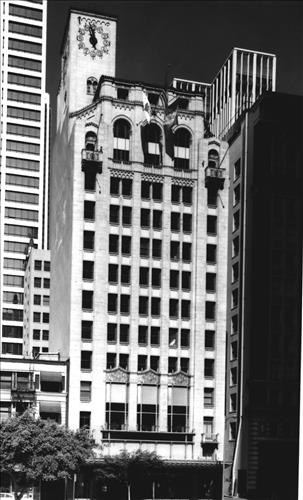The Oviatt Building was the synthesis of James Oviatt's business acumen, style, and sense of design. Although numerous architects, engineers, designers, and craftsmen contributed their talents to the creation of this building, the enemble was orchestrated by Mr. Oviatt. At the time the structure was completed in 1928 and fifty years later when it was rehabilitated, the Oviatt Building has set a standard for innovative design.
When the building opened, it was publicized for the opulent Art Deco appointments, the novelty of incorporating a penthouse, and the personal attention that Mr. Oviatt lavished on his store and residence. Although Los Angeles was used to extravagant displays, Oviatt's grand gesture of engaging the finest French avant garde designers was worthy of special notice. The penthouse provided the sophisticated and elegant image that Oviatt wished to project to his clientele, while, the store furnished the proper luxurious setting for his beautiful men's and women's fashions. It was a direct link to the 1925 Paris Exposition Internationale des Artes Decoratifs et Industriels Moderne that was profoundly affecting the world of architecture and design.
As the result of the recent preservation and rehabilitation of the Oviatt Building, it has become the best known example of recycling a heritage building in the city. The Rex II Ristorante, the restaurant that replaced the clothing store, has set a standard for the sensitive treatment of an historic interior, luxury, and sophisticated dining.
James Cviatt (1888 - 1973) came to Los Angeles from Salt Lake Cityin 1906. He worked for Desmonds until 1911 when he went into partnership with Frank Alexander. Alexander and Oviatt were among the leading clothiers in the city. Their affluent customers were offered the finest clothes, some of which Oviatt designed. In order to stay abreast of the fashions, Oviatt spent a portion of each year buying fabrics and goods in Europe. After occupying two locations, the firm leased the present land andbegan to plan a new building in 1927. The building was open in 1928.
The team Oviatt assembled included Walker and Eisen, architects and engineers; Fell and Paradise, store designers; Rene Lalique, the genius of French glassmaking; Saddier et Fils, cabinetmakers; and numerous craftsmen and suppliers. Oviatt was more than a willing client with taste and the financial ability to obtain the finest quality. He was also an active participant in the desing and furnishing of the building.
Valker and Eisen were primarily responsible for the shell of the building and the Olive Street facade. Percy Augustus Eisen (1885-1946) and Albert Raymond Walker (1881-1958) were in partnership from 1919 to 1940. During the 1920's they had one of the largest offices in the city. Their early work included offices, hotels, and apartment houses executed in eclectic motifs. Their later works were mostly government buildings, theaters, and branch facilities carried out in the Moderne style. Major commissions included the Fine Arts Building (1925), United Artists Building (1927), Title Insurance Building (1928), National Bank of Commerce (1929), Fruit Growers Exchange (1954), Beverly-Wilshire Hotel (1926), El Cortez Hotel (San Diego 1927), El Mirador Hotel (Palm Springs 1927), Mar Monte Hotel (Santa Barbara 1927), Torrance City Hall, Jail, and Municipal Building (1936), and the San Luis Obispo County Court House (1940).
The Oviatt Building went into decline in the 19oO's along with the rest of downtown Los Angeles. With the closure of the store in 1969 and only a small portion of the office floors rented, the Oviatt Corporation relinquished their leasehold and their interest in the building to the Archdiocese of Los Angeles in 1975.
The building was purchased in 1977 "by Ratkovich, Bowers Incorporated with the intention of rehabilitating the structure. Although other buildings such as the Biltmore Hotel and the Subway Terminal Building were being renovated at the same time, it was the Oviatt that became the most widely recognized example of preservation and recycling in downtown Los Angeles. The owners became identified with this form of development and have gone on to other adaptive reuse projects such as the Wiltern Theater. The work by Brenda Levin, Associates and Luciano DeNardi to create the interior of the Rex II Ristorante has been acclaimed as an exceptional example of adaptive reuse design.

